Fantasy Books
Women in SF&F Month: A. G. Slatter
This week of Women in SF&F Month starts with an essay by A. G. Slatter! Her work includes The Bitterwood Bible and Other Recountings (winner of the World Fantasy Award for Best Collection), Of Sorrow and Such (winner of the Ditmar Award for Best Novella), and The Path of Thorns (winner of the Aurealis and Australian Shadows Awards for Best Fantasy Novel). Her most recent novel, the gothic fantasy The Crimson Road, is described as “a tale of vampires, assassins, ancient […]
The post Women in SF&F Month: A. G. Slatter first appeared on Fantasy Cafe.Spotlight on “The Art Spy” by Michelle Young
The Art Spy, a riveting and stylish saga, uncovers how an unlikely heroine infiltrated the…
The post Spotlight on “The Art Spy” by Michelle Young appeared first on LitStack.
Windy City Pulp & Paper 2025 – ‘If Bob Were Here…’
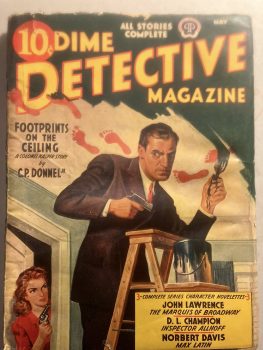
 It’s an early A (Black) Gat in the Hand, as I got my Pulp on week before last, at Windy City, in Chicago.
It’s an early A (Black) Gat in the Hand, as I got my Pulp on week before last, at Windy City, in Chicago.
I managed to resist the impulse to grab the microphone in the Dealers Room and proclaim, “Finally….The Bob…has come back…to Windy City.” A little classic Rock for you there. And in not doing so, I wasn’t evicted and had a great time.
Doug Ellis puts on the Windy City Pulp and Paper Convention annually at the Lombard Westin, in the suburb an hour west of Chicago. I last attended in 2019. Of course, COVID hit in 2020, along with some other life changes. I made it to my first Howard Days in 2022, and headed over to Pittsburgh the last two years for Pulp Fest. Windy City just didn’t quite happen. But I made sure it did in 2025.
There’s an auction, some panels, an art show, and a massive Dealer Room. I’ll share my purchases here in a minute. But hands down, the best part of Windy City for me, is hanging and chatting with people. I see lots of online friends and some folks I’ve met before. I even make new friends. Sort of.
Walking around the Dealer Room and getting into conversations on pulp or paperback favorites is a blast. I find somebody to chat Nero Wolfe, or Jo Gar, or Solar Pons, or Solomon Kane, or Bail Bond Dodd, or…you get the idea. I found myself showing my Civil War shelfie to someone, as they talked about Shelby Foote.
There are always folks sitting around the lobby. I’ve met new friends just sitting down and working into the conversation. Saturday night, Ryan Harvey, Chris Hocking, James Enge, and I, spent over two hours just riffing through movies and writers. Ryan’s knowledge of multiple movie genres is staggering. And what those three knew about movie soundtracks left me soaking it in.
Add in eating a couple meals with friends, and the social aspect of Windy City is hands down my favorite part. As you’ll see, I find things to buy – and I restrain myself every year – but it’s talking about mutual interests at Windy City that is the highlight for me. Glad I made it back. See you there in 2026? Between the ever-present LA Dodgers cab, and a shirt with ‘Byrne’s Pub’ writ large on the back, I’m easy to spot.
What Did I Buy?
Max Latin!You may (or may not) know, I wrote the introduction to Steeger Books’ reissue of the collected Max Latin short stories. Norbert Davis is on my Hardboiled Mt. Rushmore, and the shady private eye Latin, is my favorite work of his. The fact that my intro replaced the last professional piece written by my favorite writer, John D. MacDonald, is awesome. You can read my intro, here at Black Gate.
For $70, I got the May 1942 issue of Dime Detective, containing “Give the Devil His Due.” This was the fifth Latin story, and I am now the proud owner of an original Latin story. There’s also a Marquis of Broadway by John Lawrence in this issue.
Gotta Have Some Howard! Will Oliver on the left. I think Security was trying to find the guy on the right, most of the show. Wait, that’s John Bullard. I stand by what I said…
Will Oliver on the left. I think Security was trying to find the guy on the right, most of the show. Wait, that’s John Bullard. I stand by what I said…
I resisted the impulse to bring home a haul of Robert E. Howard-related books. It’s easy to find more cool stuff to add to my library – even if I already have the stories included. But Robert E. Howard Foundation folks. Bill Cavalier, Paul Herman, and John Bullard were there. And breakfast with John and Paul was a conversational potpourri I won’t soon forget!
Held every June in REH’s hometown of Cross Plain, TX, Howard Days is a terrific gathering of Howard fans from all over the world. I wish I’d been into Howard back when I lived in Austin. Highly recommended weekend.
I met Will Oliver, a really cool guy (when you’re as cool as I am, you are drawn to other cool people. Yeah…) when I was down there. Will just put out an extensively referenced, door-stopper of a biography of Howard. I grabbed a copy directly from Will at the table, which he kindly signed. I am looking forward to digging into this and probably talking about it during this summer’s run of A (Black) Gat in the Hand.
Cool & LamI’ve written about my favorite Erle Stanley Gardner series many times here at Black Gate. But it’s not Perry Mason. I like the do-it-all lawyer, but the mismatched duo of Bertha Cool and Donald Lam easily hold my ESG top spot. You can find all of my Cool and Lam posts here, including the ‘lost’ pilot, with an intro by Gardner himself.
I don’t have quite all the books, and many are falling apart. As in, I’ve had to toss a couple. Those old Dell paperbacks get extremely brittle. I was happy to pick up two replacement copies at just $5 each. If you haven’t read Cool and Lam, you’re missing out on some high quality PI fiction. At least check out my first post on them, which is based on essay I wrote for Black Mask magazine (yeah, I appeared in THE Black Mask!).
The Frederick Nebel Library Grows So, Norbert Davis’s is the third face on my Hardboiled Mt. Rushmore. Frederick Nebel is number two. Nebel was the guy that Joe ‘Cap’ Shaw tapped to slide into Dashiell Hammett’s place when the latter left Black Mask (and the Pulps). My library has a lot of Nebel from Steeger Books, including Cardigan, MacBride and Kennedy, and the under-appreciated Gales & McGill.
So, Norbert Davis’s is the third face on my Hardboiled Mt. Rushmore. Frederick Nebel is number two. Nebel was the guy that Joe ‘Cap’ Shaw tapped to slide into Dashiell Hammett’s place when the latter left Black Mask (and the Pulps). My library has a lot of Nebel from Steeger Books, including Cardigan, MacBride and Kennedy, and the under-appreciated Gales & McGill.
I already had a couple of Nebel’s air adventures from Illinois’ Black Dog Books. But when I saw Tom Roberts with a table at Windy City, I couldn’t resist. I picked up Sky Blazers, plus the three books along the bottom. Also, three more non-Nebels. I have a couple other digital books from Black Dog. Tom is putting out terrific Pulp by a lot of authors who deserve to still be read. And he has some great intros (I’m still trying to con him… I mean, convince him, to let me write one). I’m a fan of Black Dog, and you should check them out.
Sky Blazers/Wolves of the Wind/Flying Freebooters
I’m not into the Air Pulp genre – in fact, I can’t really even discuss it knowledgeably (like THAT ever stops me, as you well know). But I really enjoy Nebel’s Gales & McGill series, just about all of which appeared in Air Stories, I believe.
I now own all six Nebel books from Black Dog. The top three are all air stories, a few with recurring characters. Nebel and Horace McCoy are the only Air Pulps writers I read, and I’m looking forward to more Nebel.
Flame Island and Empire of the Devil are short story collections of exotic tales from the Adventure Pulps. This is another genre I haven’t read much, but with over 600 pages of Nebel, I’ll be working my way through these. Two of the stories were made into films.
Forbidden River – Nebel started out writing Canadian adventures – you know, Mounties and trappers. Forbidden River contains five such stories. Steeger has also put out two collections of these. Nebel was writing Northern adventures when he joined Black Mask.
Roger TorreyI have the excellent short story collection, Bodyguard, in digital. I couldn’t pass up a second Torrey book: this time in print. Torrey wrote in a straight hardboiled style, and he didn’t change at all as the genre moved more towards the Cornell Woolrich or John D. MacDonald style of mysteries. He was also a major alcoholic and became unreliable and of quite variable quality. He died young, still writing for the ‘lesser’ pulps. But when he was good, he was very good, and I’m a Torrey fan.
Norvell Page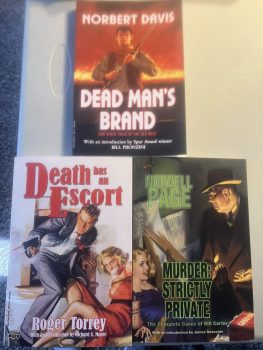 Page is best known as the primary writer of the hero Pulp, The Spider (under the house name, Grant Stockbridge). Like most Pulpsters, he wrote many genres, including weird menace, and G-men stories. I have his limited Western output as a Black Dog e-book.
Page is best known as the primary writer of the hero Pulp, The Spider (under the house name, Grant Stockbridge). Like most Pulpsters, he wrote many genres, including weird menace, and G-men stories. I have his limited Western output as a Black Dog e-book.
I really struggle with the Spicy Pulps. Briefly a popular genre, they’re just so goofy I can’t take them seriously enough to enjoy them. I wrote a post on a Robert E. Howard spicy story – and it was more of a saucy-tinged adventure. Whereas, I can’t even finish a Dan Turner (Hollywood Detective) story
in one -sitting.
Robert Leslie Bellem’s Turner is the most popular of the spicy detectives, even getting his own magazine. But to me, it’s like a parody of Race Williams. And Williams can be hard enough to absorb, without making it a spicy parody.
Page wrote a series of spicy stories featuring Bill Carter (who is not his Weird Menace star, Ken Carter), an investigative reporter in Miami. This volume collects (all?) twenty of them. Page is still kinda over-the-top for me, but these are FAR more readable than the Dan Turner stories. I’ll work my way through this book.
Norbert Davis’ WesternsI already had this in digital, but I couldn’t pass up the print edition. Davis didn’t write many Westerns, but he wrote some damn good ones. I already did this Black Gate post on one of my favorites, “A Gunsmoke Case for Major Cain.” I plan on covering a couple more for the summer Pulp series along the way. I really like his Westerns.
MISCI also picked up a Dell Mapback of Rex Stout’s Tecumseh Fox mystery, Double for Death. I like Mapbacks, and try to pick up one or two when they aren’t too expensive. I got a few Stouts last year at Pulp Fest.
Also, you should definitely attend Windy City next year if you want to play ‘If Bob Were Here.’ To hear something I said repeated back conversationally with “If Bob were here, I bet he would say…” I’m used to being ragged on. To combine it with being ignored is really impressive!
The Art Room

 I snapped a few pics of the really cool stuff in the Art Show, but I wish I had been dialed in for it. I would have gotten a lot. The Mark Wheatley, and Gary Gianni stuff, had most of my attention. But there was some neat REH and Edger Rice Burroughs stuff too.
I snapped a few pics of the really cool stuff in the Art Show, but I wish I had been dialed in for it. I would have gotten a lot. The Mark Wheatley, and Gary Gianni stuff, had most of my attention. But there was some neat REH and Edger Rice Burroughs stuff too.
I like this El Borak print by Jim and Ruth Keegan, from the Wandering Star/Del Rey books. There was a cool Solomon Kane pic by Gianni. There was a statue in front of it which it mirrors. I wish I’d taken a close up of it. I will be more focused when I visit the Art Room next time.
Gary Gianni was selling five prints for $30 – signed, at a table. I snagged them! There were four Solomon Kanes – color, and black and white. Also, one larger sized Conan from “A Witch Shall Be Born.”
He chatted with folks and is a super nice guy. I’m friends with Bill Cavalier (well, I don’t think he refutes that statement, anyways) and have met Mark Wheatley and Mark Schulz at Pulp Fest. Robert E. Howard artists have been really nice folks.
THE HOWARD ANDREW JONES PANEL
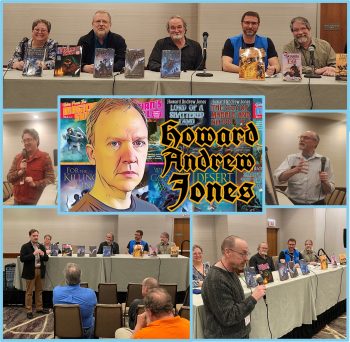 A lot of Howard’s friends and fans were at Windy City. There was a panel to remember and celebrate Howard, curated by his biggest fan and supporter, Arin Komins. John O’Neill, James Enge, Seth Lindberg, and John Hocking shared thoughts and memories. Audience members were also offered the opportunity to speak, and Howard’s fellow Black Gaters Ryan Harvey, Greg Mele, and myself, spoke fondly of our missed friend.
A lot of Howard’s friends and fans were at Windy City. There was a panel to remember and celebrate Howard, curated by his biggest fan and supporter, Arin Komins. John O’Neill, James Enge, Seth Lindberg, and John Hocking shared thoughts and memories. Audience members were also offered the opportunity to speak, and Howard’s fellow Black Gaters Ryan Harvey, Greg Mele, and myself, spoke fondly of our missed friend.
Kudos to Doug Ellis for setting aside time for Howard to be front and center. Mentions of him were peppered throughout the weekend among the Black Gate and associated crowd. We will be fondly remembering him for a long time to come.
One audience member came up and talked about helping when Howard was putting together the Harold Lamb collections. And he revealed there were some Lamb stories (four, maybe?) that they didn’t have the rights to, and I think Howard had edited those as well. Would be need to see those added to Howard’s Lamb work.
Jason Waltz – you can believe I took Arin and company to task as they were setting up the books, and there was no Hither Came Conan!
Prior Posts in A (Black) Gat in the Hand
2025 (1)
2024 Series (11)
Will Murray on Dashiell Hammett’s Elusive Glass Key
Ya Gotta Ask – Reprise
Rex Stout’s “The Mother of Invention”
Dime Detective, August, 1941
John D. MacDonald’s “Ring Around the Readhead”
Harboiled Manila – Raoul Whitfield’s Jo Gar
7 Upcoming A (Black) Gat in the Hand Attractions
Paul Cain’s Fast One (my intro)
Dashiell Hammett – The Girl with the Silver Eyes (my intro)
Richard Demming’s Manville Moon
More Thrilling Adventures from REH
Prior Posts in A (Black) Gat in the Hand – 2023 Series (15)
Back Down those Mean Streets in 2023
Will Murray on Hammett Didn’t Write “The Diamond Wager”
Dashiell Hammett – ZigZags of Treachery (my intro)
Ten Pulp Things I Think I Think
Evan Lewis on Cleve Adams
T,T, Flynn’s Mike & Trixie (The ‘Lost Intro’)
John Bullard on REH’s Rough and Ready Clowns of the West – Part I (Breckenridge Elkins)
John Bullard on REH’s Rough and Ready Clowns of the West – Part II
William Patrick Murray on Supernatural Westerns, and Crossing Genres
Erle Stanley Gardner’s ‘Getting Away With Murder (And ‘A Black (Gat)’ turns 100!)
James Reasoner on Robert E. Howard’s Trail Towns of the old West
Frank Schildiner on Solomon Kane
Paul Bishop on The Fists of Robert E. Howard
John Lawrence’s Cass Blue
 Dave Hardy on REH’s El Borak
Dave Hardy on REH’s El Borak
Prior posts in A (Black) Gat in the Hand – 2022 Series (16)
Asimov – Sci Fi Meets the Police Procedural
The Adventures of Christopher London
Weird Menace from Robert E. Howard
Spicy Adventures from Robert E. Howard
Thrilling Adventures from Robert E. Howard
Norbert Davis’ “The Gin Monkey”
Tracer Bullet
Shovel’s Painful Predicament
Back Porch Pulp #1
Wally Conger on ‘The Hollywood Troubleshooter Saga’
Arsenic and Old Lace
David Dodge
Glen Cook’s Garrett, PI
John Leslie’s Key West Private Eye
Back Porch Pulp #2
Norbert Davis’ Max Latin
Prior posts in A (Black) Gat in the Hand – 2021 Series (7 )
The Forgotten Black Masker – Norbert Davis
Appaloosa
A (Black) Gat in the Hand is Back!
Black Mask – March, 1932
Three Gun Terry Mack & Carroll John Daly
Bounty Hunters & Bail Bondsmen
Norbert Davis in Black Mask – Volume 1
Prior posts in A (Black) Gat in the Hand – 2020 Series (21)
Hardboiled May on TCM
Some Hardboiled streaming options
Johnny O’Clock (Dick Powell)
Hardboiled June on TCM
Bullets or Ballots (Humphrey Bogart)
Phililp Marlowe – Private Eye (Powers Boothe)
Cool and Lam
All Through the Night (Bogart)
Dick Powell as Yours Truly, Johnny Dollar
Hardboiled July on TCM
YTJD – The Emily Braddock Matter (John Lund)
Richard Diamond – The Betty Moran Case (Dick Powell)
Bold Venture (Bogart & Bacall)
Hardboiled August on TCM
Norbert Davis – ‘Have one on the House’
with Steven H Silver: C.M. Kornbluth’s Pulp
Norbert Davis – ‘Don’t You Cry for Me’
Talking About Philip Marlowe
Steven H Silver Asks you to Name This Movie
Cajun Hardboiled – Dave Robicheaux
 More Cool & Lam from Hard Case Crime
More Cool & Lam from Hard Case Crime
A (Black) Gat in the Hand – 2019 Series (15)
Back Deck Pulp Returns
A (Black) Gat in the Hand Returns
Will Murray on Doc Savage
Hugh B. Cave’s Peter Kane
Paul Bishop on Lance Spearman
A Man Called Spade
Hard Boiled Holmes
Duane Spurlock on T.T. Flynn
Andrew Salmon on Montreal Noir
Frank Schildiner on The Bad Guys of Pulp
Steve Scott on John D. MacDonald’s ‘Park Falkner’
William Patrick Murray on The Spider
John D. MacDonald & Mickey Spillane
Norbert Davis goes West(ern)
 Bill Crider on The Brass Cupcake
Bill Crider on The Brass Cupcake
A (Black) Gat in the Hand – 2018 Series (32)
George Harmon Coxe
Raoul Whitfield
Some Hard Boiled Anthologies
Frederick Nebel’s Donahue
Thomas Walsh
Black Mask – January, 1935
Norbert Davis’ Ben Shaley
D.L. Champion’s Rex Sackler
Dime Detective – August, 1939
Back Deck Pulp #1
W.T. Ballard’s Bill Lennox
Erle Stanley Gardner’s The Phantom Crook (Ed Jenkins)
Day Keene
Black Mask – October, 1933
Back Deck Pulp #2
Black Mask – Spring, 2017
Erle Stanley Gardner’s ‘The Shrieking Skeleton’
Frank Schildiner’s ‘Max Allen Collins & The Hard Boiled Hero’
 A (Black) Gat in the Hand: William Campbell Gault
A (Black) Gat in the Hand: William Campbell Gault
A (Black) Gat in the Hand: More Cool & Lam From Hard Case Crime
MORE Cool & Lam!!!!
Thomas Parker’s ‘They Shoot Horses, Don’t They?’
Joe Bonadonna’s ‘Hardboiled Film Noir’ (Part One)
Joe Bonadonna’s ‘Hardboiled Film Noir’ (Part Two)
William Patrick Maynard’s ‘The Yellow Peril’
Andrew P Salmon’s ‘Frederick C. Davis’
Rory Gallagher’s ‘Continental Op’
Back Deck Pulp #3
Back Deck Pulp #4
Back Deck Pulp #5
Joe ‘Cap’ Shaw on Writing
Back Deck Pulp #6
The Black Mask Dinner

Bob Byrne’s ‘A (Black) Gat in the Hand’ made its Black Gate debut in 2018 and has returned every summer since.
His ‘The Public Life of Sherlock Holmes’ column ran every Monday morning at Black Gate from March, 2014 through March, 2017. And he irregularly posts on Rex Stout’s gargantuan detective in ‘Nero Wolfe’s Brownstone.’ He is a member of the Praed Street Irregulars, founded www.SolarPons.com (the only website dedicated to the ‘Sherlock Holmes of Praed Street’).
He organized Black Gate’s award-nominated ‘Discovering Robert E. Howard’ series, as well as the award-winning ‘Hither Came Conan’ series. Which is now part of THE Definitive guide to Conan. He also organized 2023’s ‘Talking Tolkien.’
He has contributed stories to The MX Book of New Sherlock Holmes Stories — Parts III, IV, V, VI, XXI, and XXXIII.
He has written introductions for Steeger Books, and appeared in several magazines, including Black Mask, Sherlock Holmes Mystery Magazine, The Strand Magazine, and Sherlock Magazine.
You can definitely ‘experience the Bobness’ at Jason Waltz’s ’24? in 42′ podcast.
Review: A Drop of Corruption by Robert Jackson Bennett (Reviewed by Caitlin)

Buy A Drop of Corruption
Read a review of Book One, The Tainted Cup
Read Lukasz's review of A Drop of Corruption
OVERVIEW/ANALYSIS: Investigators Ana and Dinios are used to unusual crimes, so investigating the disappearance of a Treasury officer from a locked room is a relatively trivial matter. It's only a matter of hours before Ana not only works out how the person disappeared, but also deduces that they have been murdered as well. But as to who did it and why? That's a much trickier mystery to solve. The culprit seems to possess an almost supernatural ability to circumvent security measures and to anticipate Ana's investigation. The only thing Ana knows for sure is that the murderer's ultimate target is the Shroud, a high-security factory where the Empire harvests the leviathan blood that drives so much of it. And if the Shroud falls, the Empire could fall with it.
A Drop of Corruption is another rousing success from Robert Jackson Bennett, at once both a twisty mystery and harsh critique of colonialism. Returning fans will settle right back in with Ana and Din's familiar cadence: Din does the leg-work, interviewing witnesses and assessing crime scenes, while Ana takes the information and works out how the pieces come together. I was glad to see how Din had grown into his role, understanding that Ana's sometimes odd requests always have a reason, and knowing what kinds of information Ana is looking for.
Even though Ana and Din are working on behalf of the Empire, this is not a book that takes the side of the Empire. Instead, it uses the mystery to examine the messy can of worms that comes from colonizing an already inhabited land. While many of those Din interviews are high level officials, there is attention paid to the common folk who get caught in the middle of the political games between the Empire and the native regional government. The story also acknowledges that there are no clean solutions to the problem, as the Empire pulling out of the colony comes with its own set of headaches and injustices.
This book never feels like a lecture, however, because the message is blended with the absolutely engrossing world-building. A Drop of Corruption continues to iterate on the weird alchemical enhancements introduced in the first book, introducing us to new weird ways people alter themselves in this world. And in the process of delving deeper into the science of alchemy...well let's say some past things that may have registered as off to some readers may start to make sense.
CONCLUSION: In short, A Drop of Corruption further solidifies Robert Jackson Bennett as an autobuy author for me. From his deep, intricate world-building to his real world commentary, every one of his books is a full meal. Even if you're just here for the mystery, you're going to have a great time. But for those who just want to lose themselves in a completely different world? You need to pick his books up.
Neverwhens: War “On Earth, As it Is in Heaven” — Rebecca Roanhorse’s Mirrored Heavens
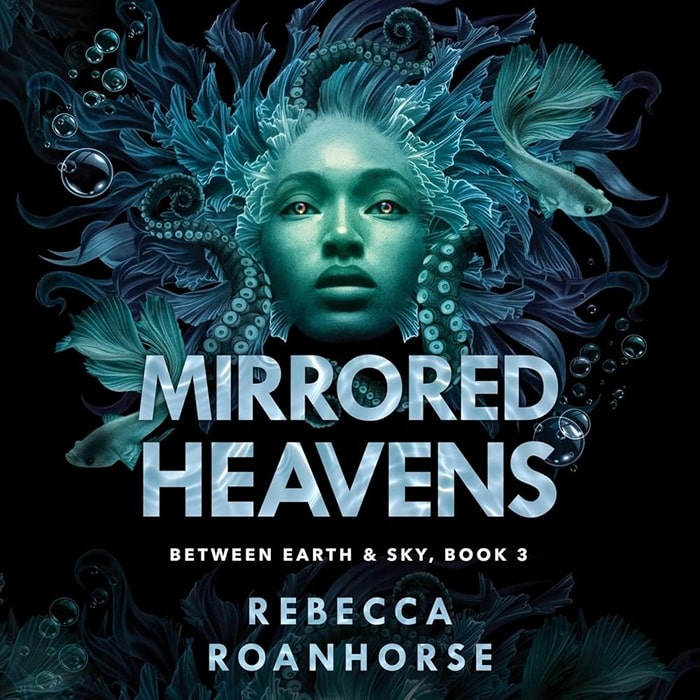 Mirrored Heavens by Rebecca Roanhorse (Saga Press, June 4, 2024)
Mirrored Heavens by Rebecca Roanhorse (Saga Press, June 4, 2024)
Between Earth & Sky has always been about doing something fresh.
Rebecca Roanhorse set out to create an epic fantasy set in a world based on the pre-contact Americas. It has its Maya, Cahokia, Ancestral Puebloan and Woodlands analog cultures; it has a seafaring matriarchy that is a bit Polynesian, a bit Caribbean, a bit “this would be cool.” But the world of The Meridian is its own thing. At times the technology is greater than what existed in our world, it has giant crows, eagles, insects and winged serpents tamed as mounts and its gods are very real, and not particularly benevolent.
But if the world the author sets her fantasy is drawing from cultures underused in fantasy, the story-structure is unique as well. This is not a story of a rising dark lord and the plucky heroes that rise against him. Its villains are all-too-human, motivate by sometimes petty desires, sometimes misplaced love, and if there is a “Dark Lord”, well he is one of the most sympathetic characters in the entire tale.
None of this is inversion for inversion’s sake; it is about telling a compelling, fresh story that feels authentic to the sources that inspired its author, and now it has all come to an end with Mirrored Heavens.
Sticking a landing is always tricky and Roanhorse to some extent set herself a challenging task at the end of Book 2. The mid-book of a trilogy is always a bridge story of revelations and few resolutions, but in Fevered Star we only truly see into the villain’s mind — or even realize his full roll — in the last third of the book. Our two main pairs of heroes: Serapio and Xiala, Narampa and Ixtan, spend the novel separated while the fifth main hero, Okoa, is mostly haplessly dragged from bad decision to bad decision. Things end with the predictable “it’s even worse now”, but other than an epic, beautifully rendered clash between Serapio and Narampa, as respective avatars of the Crow and Sun, in some ways the stage feels unset for resolution in one volume.
That would all be true if Roanhorse was trying to write The Lords of the Rings, pre-Contact Americas style. But she isn’t, and her story isn’t triggered by plot, but by characters. If there is a reveal in Fevered Star it is that all of our main characters, even the villainous Balam, have been motivated by personal relationships, disappointments or love. For all the interplay of ancient gods and prophecies, the story is indeed about Serapio and Xiala, Narampa and Ixtan, Okoa and yes, even evil Balam. It’s about family and isolation, a desire to belong and be loved, or what happens when that instead turns into possessive control. Consequently, to borrow a line from the otherwise wretched The Last Jedi: This isn’t going to go how you think it will.
Reading the above, one might think this is a very literary, slow book. It is not. From the first page there is assassination attempts, blood magic, scary monsters and marching armies. As with the first two volumes, Roanhorse’s prose is tight, sometimes even clipped, and her pages fly by. The summary of our situation: Serapio, now the Carrion King and ruler of Tova, is trying to cement his rule as the Crow clan’s living messiah, and knows that besides the other clans wishing to murder him, the rulership of his own clan has no love for being supplanted by living avatar.
All the other cities of the confederacy are marshalling against him, and he doesn’t even know that the villain behind it all is the man who sent him on his quest — and has been involved in his very creation from the start. He is presented with a prophecy, supposedly from the maw of the trickster god Coyote himself that says that if he slays his “unloved bride” and his father, he can win the three different wars brewing against him, but only by losing everything. What the hell does that mean, and how much further into dark, even cruel, paths will Serapio descend to fulfill it. Indeed — is he even the “good guy” and what is he trying to win?
Okoa, as brother to the Carrion Crow matron, has come to respect and idolize Serapio, but like everyone — fears him. His sister reveals the other clan matrons have learned of a weapon that can slay the Carrion King and demands Okoa’s help.
Narampa feels the power of the Sun growing in her and has fled to the north, to the Graveyard of the Gods — where it is said the gods made war and were “slain”/banished from the mortal world — seeking a shaman who can teach her how to use the mysterious godflesh mushrooms that will allow her to enter the various spirit worlds and fight to liberate her city from the Crow. Only she, too, does not realize Serapio is not the problem…
Ixtan is in the city of Hokaia, adrift and unsure what their path now is, until they learn that Narampa lives and that the southern lord Balam is at the heart of everything. A dangerous thing for a “Priest of Knives” to learn.
Xiala has returned home to the isles of the reclusive Teek. Her mother dead, she should be queen — a role she has run from. But Lord Balam’s agents have come to enslave the Teek, and somehow she has to save her people and find a way back to Serapio to warn him.
Seem like spoilers? That’s where we pick up and in a way that’s all you need to know. The rest of Mirrored Heavens is about how each of these players follows that path, and a revelation of how Lord Balam came to be bent on quest of the cities of the Meridian. The resolution will have blood magic, shadow worlds, a clash between gods, love and definite loss…and it won’t be what you think.
Now, confession: I came close to rating this to four stars because, with so much to resolve and tie up, it is only within the last 70 pages of a 600-page novel that it all starts to come into motion. The final clash is certainly dramatic, maybe almost too much — it feels very much like the final confrontation scene would expect in a Marvel movie, or at least an 80s adventure film. For all of the build-up, Serapio and Narampa are not fated to meet again and, indeed, many characters here fail to understand their role in the story, or make choices that lead to worse, not better, and never do recover from it.
A key to victory comes from an idea introduced about five pages before it is used, which felt contrived. Finally, the more we learn of Lord Balam’s backstory, the less competent he seems, and more like the real-world’s over-privileged billionaires who are interfering in the modern world simply because they can, they have the resources to bully their way in, and because they don’t like being told no. It all felt a bit rushed, and not always fair to the characters we’d been running with for 1600 pages.
Then I read the two final chapters, that serve as epilogues.
As I said at the start of this review, Rebecca Roanhorse isn’t trying to write a “Native American Lord of the Rings“, she is telling her own tale, and when you get to the end it all clicks. Besides tying every loose end, the other choices: a somewhat tragic, almost pointless, death of a main character; the fact that an assassin not only gets away with it, but parleys their actions into more power; the fact that some of the great heroism of a character is never known or understood — yes, that’s how the world works in politics and in war.
The gods are real, yet their ultimate appearance remains vague, unclear, and seemingly uncaring of mortal cost because they are gods — not mortals writ large. There is nothing of the Classical or Judeo-Christian belief to these deities; they are primal and simply are — once they act, mortals are left to reason for themselves what it all means. Scenes that occur off-stage do so because they really tell us nothing about the interplay of the core characters, and that’s what this story has always been about: a small group of players caught in the center of a revenge decades in the making.
Could the end have been a bit longer? Perhaps. Do I still think Lord Balam never really quite works as the chief villain? Somewhat. Is the “secret weapon” introduced just before it is needed… needed. No. But in the end, that doesn’t matter: Mirrored Heavens is ultimately about people and in telling that story, Roanhorse creates a magic and adventure-filled conclusion to one of the freshest epic fantasies I’ve read in years. I am already missing Serapio, Xiala, Ixtan and the rest, and although the story of The Meridian seems complete, Roanhorse mentions a distant western Empire of the Boundless Seas and other lands I’d eagerly visit.
(You can read my review of volume one here: Neverwhens, Where History and Fantasy Collide: Brilliance Gleams Beneath a Black Sun.)
Women in SF&F Month: Week 3 Schedule & Week in Review
The fourteenth annual Women in SF&F Month continues tomorrow, with four new guest posts and a cover reveal/book giveaway coming up this week. Thank you so much to last week’s guests for their wonderful essays! Before announcing the schedule, here are last week’s guest posts in case you missed any of them. All guest posts from April 2025 can be found here, and last week’s guest posts were: “Crayon Trails: On Friendship, Grief, and an Unlikely Book Deal” — Roanne […]
The post Women in SF&F Month: Week 3 Schedule & Week in Review first appeared on Fantasy Cafe.Tubi Dive, Part I
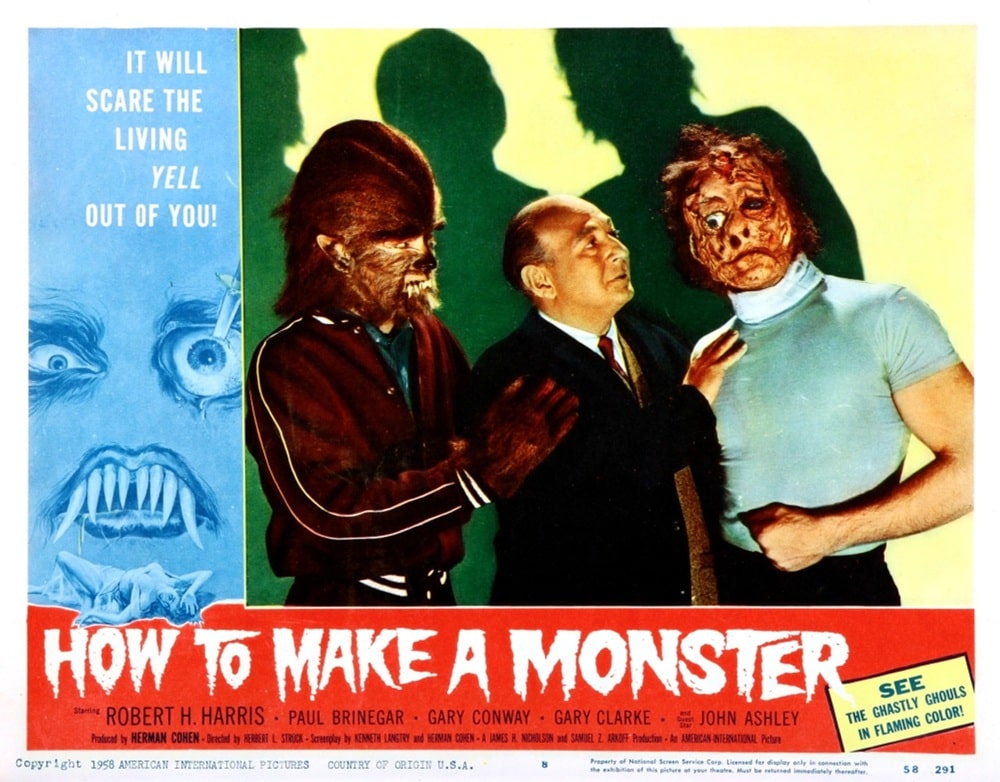 How to Make a Monster ( American International Pictures, July 1, 1958)
How to Make a Monster ( American International Pictures, July 1, 1958)
50 films that I dug up on Tubi.
Enjoy!
How to Make a Monster – 1958, AIPAs a slight deviation from our usual programming of themed lists, here are the results of a deep dive I recently undertook, pushing Tubi to the limits. So here we are with How to make a Monster, a follow-up of sorts to the two spectacular schlock movies, I Was a Teenage Frankenstein and I Was a Teenage Werewolf, both released a year earlier in 1957 from American International Pictures. Monster double-billed with Teenage Caveman (which I previously reviewed when I was on my cave people kick), and is probably my favorite of the film series.
It isn’t your usual narrative, but rather a meta-tale of the studio itself, and I LOVE movies about making movies. In this one, Pete Dumond, the ‘Jack Pierce’ of his day, is the makeup wizard who designed and applied the prosthetics for the two previous films. When he discovers that the studio has been taken over by a company that isn’t interested in monster films, and is subsequently fired, Pete goes on a murderous rampage, only he doesn’t do the killing himself. Instead he brainwashes the young actors playing the monsters via a strange foundation cream (bear with me here) and coerces them to killing the new studio stooges while in full makeup.
Eventually, the cops figure out what is going on, and it all ends up in a rather bonkers and fiery final act. One of the great gimmicks employed here is the final reel being in full colour (a similar stunt was pulled on Teenage Frankenstein), and it’s quite jarring, but in a good way. Fun stuff!
7/10
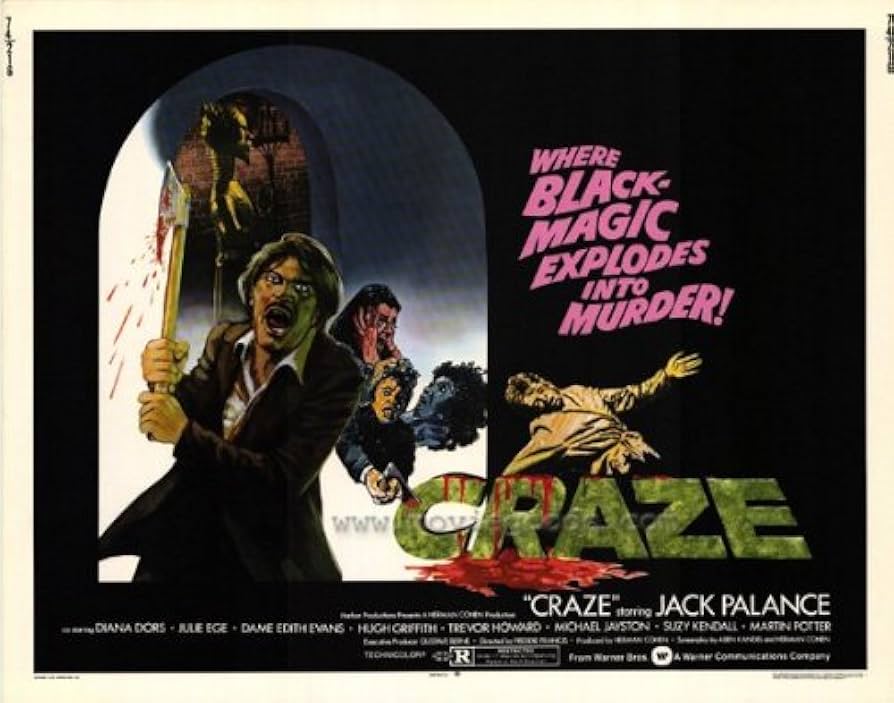 Craze (Warner Bros, June 5, 1974)
Craze (1974)
Craze (Warner Bros, June 5, 1974)
Craze (1974)
A strange little film from one of my favorite directors, Freddie Francis (who hated this one), Craze is based on the novel The Infernal Idol by Henry Seymour. It tells the story of an English antiques dealer who is wrapped up in black magic, and who worships a spooky African idol called Chuku. After a bloody alter, he begins to associate human sacrifices with financial gain (via Chuku), and promptly goes on a murderous spree to keep his idol happy.
Jack Palance is the most unconvincing Englishman ever put on film (until Keanu in Dracula), but he is ably supported by Julie Ege, Diana Dors and Trevor Howard. There are moments that echo the Amicus glory days, however it’s an uneven film, and the version I watched appeared to be edited for ghastliness.
Good if you’re planning a scary idol night.
5/10
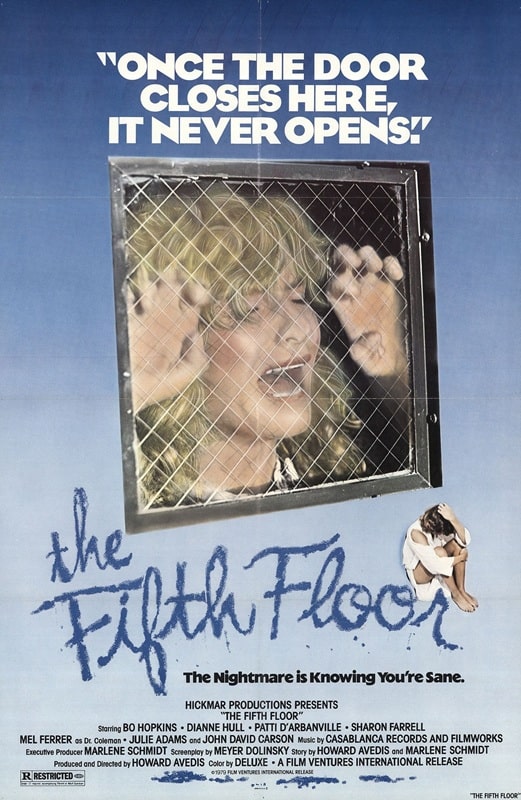

The Fifth Floor (Film Ventures International, November 15, 1978)
and The Boneyard (Zia Film Distribution, June 12, 1991)
Based on a true story, The Fifth Floor is about a young woman, Kelly (played by Diane Hull), who is accidentally poisoned at a disco and is taken to hospital. Her records indicate that she has tried to self harm before at age 15, so she is recommended for psychiatric assessment and care, leading to a three day stay at a facility. She soon runs afoul of a sleazy attendant, and her stay is increased to two-weeks, eventually being drawn out to 60 days. During this time she is abused, both mentally and sexually, and nobody believes her, especially her useless boyfriend.
It’s a pretty run of the mill movie, but the cast is the standout, and makes this an interesting watch. As with One Flew Over the Cuckoo’s Nest, the patients are portrayed by some familiar faces, notably Robert Englund (fresh off telling his roommate to try auditioning for a space movie…), Anthony James (the villain in every TV show and film you ever watched), Earl Boen (who would go on to become a psychiatrist himself in the Terminator films), and Michael Berryman (of course).
The uncaring boss of the facility is played by Mel Ferrer, and the sleazy, abusive orderly is played by none other than Bo Hopkins. Julie Adams plays one of the nurses, so of course this Black Lagoon lover was very happy about that.
Not fun, but I didn’t hate it, which is high praise considering the films I seek out.
5/10
The Boneyard (1991)Here’s an interesting one I hadn’t seen before, and when I say interesting, I mean a bit dull, then utterly barking mad.
Two years before The X-Files gave us Mulder and Scully, The Boneyard gave us Jersey Callum (Ed Nelson) and Alley Oates (Deborah Rose), a detective and psychic respectively, both at the end of their games and leaning against each other for support. A child murder case leads them both to a vast mortuary, run by Phyllis Diller (who totally over-Dillers every scene she’s in). Before you know it the child corpses turn out to be flesh-eating demons, and shenanigans ensue.
Yes, this one is painfully slow to get started, but once it does, it’s a lot of fun. The child demons are quite ghastly and really well made, and it’s a pity the same cannot be said for the two goofy monsters that crop up toward the end. James Cummings was a bit of a makeup legend before he tried his hand at directing, and it showed in the monsters — unfortunately the rest of his direction was really pedestrian.
There are some hilarious moments, some gooey moments, and a poodle moment that would make Ang Lee go off in his pants. Worth a look if you’re feeling brave.
6/10

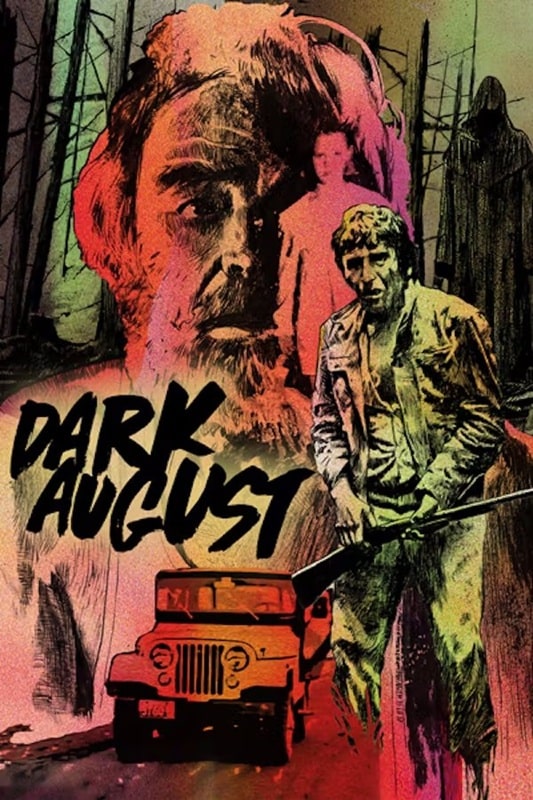
Schizoid (The Cannon Group, September 5, 1980)
and Dark August (Howard Mahler Films, September 10, 1976)
Next up is this non-politically correctly titled slasher from the start of the best decade. Someone is stalking and murdering the members of a therapy group run by the terminally horny Dr. Fales (Kinski).
A newspaper columnist (Marianna Hill) is being sent threatening letters, and the cops (led by Richard Herd) don’t take them seriously. Her creepy ex-husband (Craig Wasson) is more concerned with getting the wallpaper up in his office (!), and Kinski shags everyone.
It’s fine, I guess, except the mystery killer is given away at the beginning. Oh, and Christopher Lloyd is in it, being all weird and sinister, so a bonus point there.
1/10
Dark August (1976)Sal, an artist recently moved from NY to Vermont, doesn’t do a good job of fitting into his new rural life because he immediately runs over a young girl. It’s an accident, but the girl’s spooky grandfather doesn’t see it that way, and proceeds to voodoo Sal up the wazoo.
Creepy apparitions, bloody coughing and tummy aches ensue. It’s a bit slow, but there is a handful of inspired shots. Kim Hunter is in it as a committed medium, so that’s a bonus.
1/10
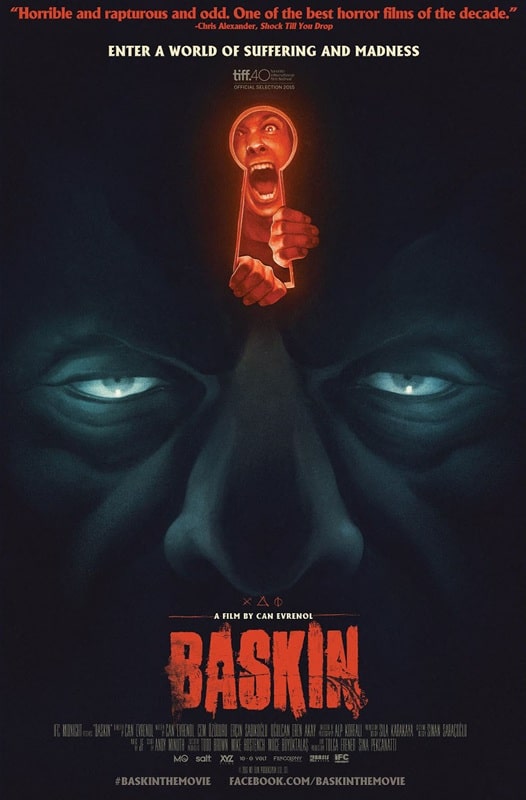 Baskin ()
Baskin (2015, Turkey)
Baskin ()
Baskin (2015, Turkey)
Just five months after the US Thanksgiving celebrations, here is a delicious slice of Turkey, all wrapped up in one hell of a mind-bending horror film.
Baskin is a simple tale about a squad of police officers just mooching about, not doing much, when they get a call to a ‘disturbance’ in a dodgy part of town.
They answer the call, but crash their van along the way and end up at a big old house. The minute they go inside they are confronted by assorted ghastliness, and another officer banging his own head against a wall, and then it all goes rapidly downhill.
They find themselves quite literally in Hell surrounded by writhing masses of flesh and blood, and soon they are in the clutches of a cannibalistic cult, led by an enigmatic and terrifying figure. The sense of dread is astounding, and the film itself is gorgeous, albeit utterly horrific. Its surreal sensibilities put me in mind of Mandy (2018), and its overall sense of doom reminded me of Descent or Dog Soldiers. It’s a bit of a hard watch, and certainly not fun, but it’s worth a watch if you fancy something darker (and stickier) than molasses.
8/10
Previous Murkey Movie surveys from Neil Baker include:
What Possessed You?
Fan of the Cave Bear
There, Wolves
What a Croc
Prehistrionics
Jumping the Shark
Alien Overlords
Biggus Footus
I Like Big Bugs and I Cannot Lie
The Weird, Weird West
Warrior Women Watch-a-thon
Neil Baker’s last article for us was Part III of What Possessed You? Neil spends his days watching dodgy movies, most of them terrible, in the hope that you might be inspired to watch them too. He is often asked why he doesn’t watch ‘proper’ films, and he honestly doesn’t have a good answer. He is an author, illustrator, teacher, and sculptor of turtle exhibits. (AprilMoonBooks.com).
Exhilerating Escape! 6 Mind-Bending Science Fiction & Fantasy Novels
Alright, let’s talk about science fiction novels and fantasy novels, and escape reality for a…
The post Exhilerating Escape! 6 Mind-Bending Science Fiction & Fantasy Novels appeared first on LitStack.
GODKILLER by Hannah Kaner
Tor Doubles #1: Arthur C. Clarke’s Meeting with Medusa and Kim Stanley Robinson’s Green Mars
 Meeting with Medusa cover by Vincent di Fate
Meeting with Medusa cover by Vincent di FateGreen Mars cover by Vincent di Fate
Tor Double #1 was originally published in October 1988. This volume marked the beginning of the official Tor Double series. The two stories included, Arthur C. Clarke’s Meeting with Medusa and Kim Stanley Robinson’s novella Green Mars complement each other, although by doing so, Green Mars also points out a weakness of Meeting with Medusa. The volume was published as a tête-bêche, with both covers were painted by Vincent di Fate.
Meeting with Medusa was originally published in Playboy in December, 1971. It was nominated for the Hugo Award and Nebula Award, winning the latter, as well as the Seiun Award.
The novella opens with Captain Howard Falcon commanding a massive airship, the Queen Elizabeth IV, over the Grand Canyon. A collision with a drone camera causes the ship to crash, killing nearly everyone on-board, including the uplifted chimpanzees who served as part of their crew. Although horribly injured in the crash, Falcon survived and spends years regaining his ability to function, eventually returning to his job as a pilot with an audacious plan.
Falcon proposed a mission to fly through Jupiter’s atmosphere. He notes that many probes have been lost in the atmosphere, but believes that he is uniquely qualified for a crewed mission because he can take evasive action if necessary, noting that he was not at the helm when the Queen Elizabeth IV was struck. His proposal seems like a mix of hubris and a need to atone for the loss of the airship. While Falcon’s reasoning may make sense, the decision to fund and permit him to take on the mission seems a little too pat. However, characterization and motivation has never been Clarke’s forte.
Where Clarke excels, and where Meeting with Medusa succeeds, is building a sense of wonder for the reader. Extrapolating from what was known about Jupiter in the years prior to the first flyby, by Pioneer 10 in 1973, Clarke creates an alien world high in the Jovian atmosphere. Buffeted by hurricane force winds, Falcon provides testimony of the miracles of life that are able to exist there, from the enormous and buoyant medusa, named for the tentacles that dangled beneath them, to the ray-like predators that glide through the skies. The size of these creatures, and the requirements for living where they do, mean that Clarke has incorporated aspects of biology that only exist on a small scale on Earth, if at all.
Gardner Dozois commented that Meeting with Medusa “is a bit traveloguish,” but there is more to the story than simply Falcon’s sightseeing through Jupiter’s skies and achieving a sense of closure for the Queen Elizabeth incident. Clarke provides a more specific reason why Falcon may be the right person for the job, but that final revelation feels a little tacked on and Clarke didn’t make full use of it throughout the story.
Forty-five years after its original publication, authors Stephen Baxter, who collaborated with Clarke, and Alastair Reynolds published a sequel to Meeting with Medusa, the novel The Medusa Chronicles, which expanded on the world Clarke described and the character who explored that world.
 Playboy cover by an unknown artist
Playboy cover by an unknown artistAsimov’s Science Fiction Magazine, September 1985, cover by J.K. Potter
The novella Green Mars was originally published in Isaac Asimov’s Science Fiction Magazine in September, 1985 and should not be confused with Robinson’s 1993 novel Green Mars. It was nominated for the Hugo Award and the Nebula Award.
Roger Clayborne, who is around 300 years old, has resigned from his position as Minister of the Interior for Mars, a position he has held for 27 years. A member of the Red Party, which championed the maintenance of Mars in its natural state, he has come to realize that his ideology has lost out to the Greens, who have successfully terraformed Mars to an extent that conserving its pristine nature is no longer possible.
In his own attempt to get back to nature, Clayborne signs on with an expedition to climb Olympus Mons, at 22 kilometers, the tallest mountain in the solar system, with a peak that juts out of the planet’s atmosphere. All expert climbers, including a woman Clayborne knew more than 250 years earlier, the trek up the mountain proves dangerous, between the threat of rockfall, weather, and the thinner Martian atmosphere.
Set over the span of several weeks, Clayborne interacts with nearly all of the other members of the expedition in various ways and the expedition leader, Eileen Monday, makes sure to rotate who partners with whom. With a cast of eleven characters, some do get short shrift (only one of the four “Sherpas” is given a last name and none of them are fleshed out), but Robinson does limn out distinctions between most of the characters, from Marie Whillans’ exuberance to Dougal Burke’s quiet competence. Roger’s interactions often depict part of the story, but Robinson makes clear that there are complex relationships behind the scenes.
Robinson also describes the climb in details, introducing the reader to a variety of concepts used to scale mountains and showing that, even with the relatively gentle slope of Olympus Mons, the ascent is difficult, with a lot of climbing and descending as paths and dead ends are discovered and materials are carefully positioned to ensure the expedition’s chance of success. At the same time, injuries happen and must be dealt with, not always in the most obvious ways.
As Clayborne climbs the mountain, the natural beauty and his discussions with the other climbers slowly begins to make him reconsider what it means to be a Red in a world in which terraforming has already taken hold. By the time he reaches the summit, he comes to a conclusion that he can still work to preserve Mars under what he considers to be less than ideal circumstances, but also understands that a terraformed Mars as a beauty all its own.
Both stories are explorations of strange vistas, with Clarke exploring the atmosphere of Jupiter and raising perceptual questions about both the concept of landscapes and life, introducing cloudbanks that were seen as mountains and massive creatures that lived in the atmosphere, never landing. Robinson presented the different layers of Olympus Mons, drawing parallels between mountains and rock formations on Earth with those on Mars as his climbers made the dangerous ascent. However, while both are explorations into the unknown, Robinson also focused on the relationships between the members of his climbing expedition, while Clarke’s protagonist spends most of the story is solitude. The result of this is that the strength of Robinson’s characters highlights the weakness of Clarke’s characters.
 Steven H Silver is a twenty-time Hugo Award nominee and was the publisher of the Hugo-nominated fanzine Argentus as well as the editor and publisher of ISFiC Press for eight years. He has also edited books for DAW, NESFA Press, and ZNB. His most recent anthology is Alternate Peace and his novel After Hastings was published in 2020. Steven has chaired the first Midwest Construction, Windycon three times, and the SFWA Nebula Conference numerous times. He was programming chair for Chicon 2000 and Vice Chair of Chicon 7.
Steven H Silver is a twenty-time Hugo Award nominee and was the publisher of the Hugo-nominated fanzine Argentus as well as the editor and publisher of ISFiC Press for eight years. He has also edited books for DAW, NESFA Press, and ZNB. His most recent anthology is Alternate Peace and his novel After Hastings was published in 2020. Steven has chaired the first Midwest Construction, Windycon three times, and the SFWA Nebula Conference numerous times. He was programming chair for Chicon 2000 and Vice Chair of Chicon 7.
A House with Good Bones - Book Review

A House with Good Bonesby T. Kingfisher
What is it about:A haunting Southern Gothic from an award-winning master of suspense, A House With Good Bones explores the dark, twisted roots lurking just beneath the veneer of a perfect home and family.
"Mom seems off."
Her brother's words echo in Sam Montgomery's ear as she turns onto the quiet North Carolina street where their mother lives alone.
She brushes the thought away as she climbs the front steps. Sam's excited for this rare extended visit, and looking forward to nights with just the two of them, drinking boxed wine, watching murder mystery shows, and guessing who the killer is long before the characters figure it out.
But stepping inside, she quickly realizes home isn’t what it used to be. Gone is the warm, cluttered charm her mom is known for; now the walls are painted a sterile white. Her mom jumps at the smallest noises and looks over her shoulder even when she’s the only person in the room. And when Sam steps out back to clear her head, she finds a jar of teeth hidden beneath the magazine-worthy rose bushes, and vultures are circling the garden from above.
To find out what’s got her mom so frightened in her own home, Sam will go digging for the truth. But some secrets are better left buried.
What did I think of it:I've talked about how Kingfisher is a master at writing horror that works on atmosphere. This book is no exception.
The tiny things that happen don't seem to bad at first, but soon they count up and I totally freaked at a scene that isn't even that bad, has actually happened to me in a minor way, but because of the atmosphere it was so creepy.And that's even with me already suspecting what might be going on.
I was totally caught by this story. Reading the last few chapters into the night because I needed to finish it, needed to see how it would end. I loved everything about it, even the creepy and freaky stuff.
I will pick up the next Kingfisher book in my TBR very soon.
Why should you read it:It's a beautiful and atmospheric Horror read.
Book Review: The Cut by C.J. Dotson
I received a review copy from the publisher. This does not affect the contents of my review and all opinions are my own.
Mogsy’s Rating: 3.5 of 5 stars
Genre: Horror
Series: Stand Alone
Publisher: St. Martin’s Press (April 8, 2025)
Length: 304 pages
Author Information: Website | Twitter
The Cut by C.J. Dotson was a book where the cover caught my attention before I even knew what the story was about. I mean, look at it! There’s just something about the image of a slimy tentacle curling out of a shower drain that instantly gives off the heebie-jeebies, and as a horror fan, I was immediately curious. Was this cosmic horror? Or some kind of creature feature? Either way, I was all for it.
At its core, The Cut is a woman trying to rebuild her life after escaping an abusive relationship. After the death of her first husband, Sadie Miles thought she’d found a second chance at love with her new fiancé Sam. But as his words became increasingly controlling and his temper harder to predict, she came to realize she and her toddler would no longer be safe—especially after discovering she was pregnant. Packing up her daughter Izzy and some meager belongings, Sadie flees to a quaint little inn called the L’Arpin Hotel, nestled on the shores of Lake Erie. There, she lands a job as a housekeeper with a temporary live-in arrangement, where she hopes to hide from Sam until she makes enough to afford her own apartment.
From the very first day, however, it’s clear something is off about the hotel and the people who work there. In the dead of night, Sadie hears the unmistakable sound of splashing in the hotel pool, only to find it empty when she arrives to investigate. Yet the management’s response is dismissive, with hints that they might even be hiding something. And when Sadie presses the issue, she begins to uncover strange occurrences that only deepen her fears. Security footage goes missing. The owner of the property next door accuses the hotel of poisoning the land. A maid disappears, which only gets covered up. Then Sadie begins to see things—squirmy things wriggling out from faucets, inside takeout boxes, and seemingly out of the very walls of the hotel itself. Sadie may have escaped Sam for now, bringing her young daughter and unborn child to what she hoped was safety, but the events unfolding at L’Arpin suggest that danger has followed them, just in a different form.
Once the story got going, I found The Cut to be a suspense and unsettling slow burn read, and several main themes began emerging. Sadie is a pregnant and single mom who has no support from her own family, and as a result has to face the challenges of fleeing abuse on her own. Dotson leans hard into the protagonist’s harrowing emotions in order to create suspense but also mixes in the gothic atmosphere of a decaying hotel that’s long past its heyday. And yes, there is a bit of Lovecraftian influence as well, bringing that particular brand of weird fiction and horror element to northwestern Ohio.
As such, this book is definitely more of a “vibe” story, aiming for creeping dread rather than in-your-face terror or all-out gore. One of the strongest aspects of the book is now the supernatural tensions mirror the emotional tensions, playing them up in tandem. The threat of Sadie’s past is never far behind, but it’s also the everyday anxieties—whether she can be the mother her children need or hold down the job that’s keeping a roof over their heads—that weigh the heaviest on her mind. Still, that’s not to say there weren’t plenty of more traditional horror elements in the book, such as disturbing imagery. It’s just not over-the-top, which, as a fan of subtler horror, I appreciated a lot.
That said, The Cut didn’t quite do it for me in every area, especially when it came to the pacing and the ending. The first half dragged in places, with the “Sadie discovers something weird, staff then proceeds to gaslight Sadie and pretend it’s nothing” pattern becoming repetitive. Her character also frustrated me at times, as more than once her decision-making made me question her intelligence. And this might just be me, but I didn’t always care for the way Sadie’s relationship with Izzy was portrayed. At times, the little girl’s behavior bordered on grating, written in a way that made her come off more like a tantum machine than a real child. Sadie’s response to that was just as hokey, as is the obnoxious “stinker” nickname she has for Izzy, making it hard to fully buy into their dynamic. Finally, the ending felt rushed, with the resolution feeling overly tidy considering how much had been built up, especially with the supernatural elements.
Still, despite a few stumbles, there’s a lot to admire here, especially for what I believe is C.J. Dotson’s debut novel. No, it isn’t perfect, but nevertheless it’s an entertaining entry into the horror genre with a strong emotional core that I think many readers will probably be able to relate to. Fans of slow burn horror with a supernatural twist will find a lot to like here, and I’ll be keeping my eye out for what the author writes next.
![]()
![]()
Goth Chick News Debuts: GalaxyCon’s Nightmare Weekend Invades Chicago, While Haunted America Ectoplasms All Over Alton
It’s been a while since we’ve had the chance to bring you a brand-new convention offering, and in 2025 we’re bringing you two. First up is one of the biggest celebrations of all things spooky, creepy, and downright chilling heading to Chicago for the first time this May. GalaxyCon, the powerhouse of fan events, is bringing its first-ever Nightmare Weekend to the Donald E. Stephens Convention Center in Rosemont, Illinois, from May 2-4, 2025 — and it’s shaping up to be an unforgettable fright fest.
“We’re thrilled to deliver our unique fan experience to Chicago,” says Mike Broder, GalaxyCon’s founder and president. “Our events have brought millions to local economies, and we can’t wait to make a positive impact in this area too.”
Translation? A weekend of scares and a boost to local businesses. Win-win!
Over three days, Nightmare Weekend will transform the convention center into a playground for horror lovers including:
- Over 100 hours of programming: Dive into Q&As, comedy, panels, screenings, gaming, and more.
- Late-night mischief: After-dark cosplay competitions, karaoke, dance parties, and cabaret performances.
- Cosplay galore: Show off your creepiest costumes and compete for glory.
- Tattooing and sinister shopping: Pick up unique merchandise or get inked to commemorate the weekend (will this be the event where I get Chris to go under the needle?).
- And the pièce de résistance? A killer lineup of celebrity guests ready to make your horror-loving heart skip a beat.
Prepare for meet-and-greets, photo ops, and autograph sessions with stars from your favorite films and shows. This year’s nightmare-worthy roster includes:
- Cast members from The Walking Dead
- The hilarious crew of What We Do in the Shadows (that’s a big “Hell yes” from us!)
- Stars of Thanksgiving (because who doesn’t love a horror twist on a holiday?)
- The spellbinding witches of Hocus Pocus
- Icons from slashers like Friday the 13th and Scream VI
- The vampy badasses of From Dusk Till Dawn
Whether you’re a hardcore horror fan or just looking for a fun weekend escape, Nightmare Weekend has something for everyone. Tickets start at just $40 and are available now at GalaxyCon’s website.
Our second new outing comes up a month later in June. The Haunted America Conference is making its spine-chilling return for the 28th year, but covering it is a first for Black Gate Photog Chris Z and I. From June 26-29, 2025, the historic town of Alton, Illinois — often hailed as one of the most haunted small towns in America — will host this legendary gathering at Lewis and Clark Community College.
And before you come for me on this one, we just report what we see for your entertainment. If we only wanted to report facts, we’d go work for the BBC.
Besides, this isn’t your typical fan convention. Founded in 1997 by renowned author and paranormal historian Troy Taylor, the Haunted America Conference offers a deep dive into the world of ghosts, hauntings, and all things unexplained.
Here’s a glimpse of what’s in store:
- Engaging Presentations: Learn from leading experts about spirits, cryptids, UFOs, and other mysteries that lurk in the shadows.
- Hands-On Workshops: Participate in sessions designed to enhance your investigative skills and understanding of the paranormal.
- After-Hours Events: For those brave enough, exclusive nighttime activities delve deeper into the unknown.
- Vendor’s Room: Browse a curated selection of eerie merchandise, from haunted relics to the latest ghost-hunting gear.
Tickets are available now, with general admission granting access to all main events on Friday and Saturday. For a detailed schedule, list of speakers, and ticket information, visit the official Haunted America Conference website.
So, stay tuned. We’ll be saving all the receipts.
Women in SF&F Month: Antonia Hodgson
Today’s Women in SF&F Month guest is Antonia Hodgson! She is the author of four historical crime novels and a soon-to-be released epic fantasy novel, The Raven Scholar. The first book in the Eternal Path trilogy, her upcoming novel is an excellent story with factions competing for a throne and a murder mystery that just opens up more and more new questions about the past. Her latest book will be out next week—on April 15 in the US and April […]
The post Women in SF&F Month: Antonia Hodgson first appeared on Fantasy Cafe.Spotlight on “Glass Century” by Ross Barkan
Glass Century by Ross Barkan is a tour de force of ambition and grace, a…
The post Spotlight on “Glass Century” by Ross Barkan appeared first on LitStack.
On McPig's Wishliat - Confessions From the Group Chat
 Confessions From the Group Chatby Jodi Meadows
Confessions From the Group Chatby Jodi MeadowsWhat happens in the group chat stays in the group chat… until it doesn’t.
Virginia Vaughn just wants to fit in with her super-popular friend group. That means she doesn’t let them know how much she loves the library, she never speaks a word about her massive crush on tragically unpopular Grayson, and she says nasty things she doesn’t actually mean. But only in the group chat, so it’s harmless, right?
But when she has a blowout fight with her clique—specifically, with the Queen Bee herself—her mean texts are posted online for the entire school to see! And, suddenly, Virginia has no one but her cat to talk to.
Cue "Knight Errant," a mystery boy at school who texts Virginia by accident—and who quickly becomes her closest confidante. Though they send messages back and forth for hours every night, Virginia doesn’t want him to know which classmate she is (because then he’ll connect her to the mean texts ALL OVER THE INTERNET). She likes him, but she really likes Grayson, too. Can she find the strength to tell Knight who she really is? And will Grayson—who has become her only ally at school—give up on her when the awful things she’s said about him are finally posted?
Confessions from the Group Chat is the second middle-grade romcom from New York Times bestselling author Jodi Meadow (BYE FOREVER, I GUESS; MY LADY JANE, now streaming on Prime). Sweet, funny, and authentically messy, this is an ultra-cute story about middle-school misbehavior, innocent first love, and the inner life of a repentant mean girl.
Expected publication October 21, 2025
Review: The Gentleman and his Vowsmith by Rebecca Ide

Buy The Gentleman and His VowsmithFORMAT/INFO: The Gentleman and His Vowsmith releases on April 15th, 2024 from Saga Press Books. It is 464 pages long and available in paperback, ebook, and audiobook formats.
OVERVIEW/ANALYSIS: To save his crumbling family estate, playboy Lord Nicholas Monterris has finally agreed to take a wife. As is tradition, that means the families of the bride and groom will be magically locked into the Monterris family manor while the magical marriage contract is negotiated and signed. To make a bad situation worse, the vowsmith for the bride's family is none other than Dashiell sa Vare, an old flame of Nicholas's who ended their relationship years ago suddenly and without warning. But all past feuds have to be set aside when people start turning up dead. Someone doesn't want this marriage to go through and they're willing to kill to make it happen. Nicholas, Dashiell, and bride-to-be Leaf have to work together to find the murderer before they end up the next victim.
The Gentleman and His Vowsmith is a well-mixed blend of Regency murder mystery and queer romantasy. It takes two rival noble families and their underlings, traps them in an isolated manor house, and mixes in a little murder and a dash of ghostly apparitions. The result is a pot bubbling over with emotions, ranging from love to resentment. In the forced proximity, people are forced to confront their unspoken affections and hash out long simmering hatred. All of this is underpinned by the overall gothic tone, the dark hallways and eerie sights that leave the guests wondering if the murderer is human...or something else.
And with all this talk of passion, now is the time to mention that this is definitely a spicy romantasy. If you're not a fan of explicit scenes, don't pick this one up. Things get hot and heavy between our leads in short order, and it carries on throughout the book. Honestly, as much as I enjoyed the catharsis of two pining lovers finally satiating themselves, at a certain point I was wishing they would keep their hands off each other for five minutes so we could get back to the murder solving.
(I also want to mention that if you're concerned that the bride in this situation gets the short end of the stick, don't worry. This isn't a situation where she's being cheated on or otherwise getting left out in the cold. She's being forced into the marriage as much as Nicholas and for various reasons is perfectly fine with him wanting to be with someone else.)
I did enjoy the queer reimagining of the Regency era, with same sex pairings fully accepted. This doesn't mean Regency society is suddenly perfect. Social stratification still exists (a noble cannot simply marry a "lowly" vowsmith") and you're still expected to carry on the family name through marriage (even if it requires something like a "stud" clause for those who don't want to sexually partner with their spouse). Nobody blinks an eye, however, at the idea of same sex relationships, as long as all the other social norms are being followed.
Overall the mystery itself is a solid twisty affair, with plenty of clues and red herrings to keep the reader on their toes. There's lots of family drama to unpack, with each new revelation providing another motive for murder. I admit, I was slightly underwhelmed by the eventual reveal of the murderer at the end of the day (given the range of options I had considered), but the journey to get to that point was satisfying.
CONCLUSION: In short, do you like murder mysteries? Do you like romantasy? If you answered yes to both questions, then do yourself a favor and pick up The Gentleman and his Vowsmith
Women in SF&F Month: Lucia Damisa
Today’s Women in SF&F Month guest is Lucia Damisa! She is the coordinator of Path2pub (Path To Publication), a website where writers offer tips and advice while sharing about their journeys and experiences. Her first novel, A Desert of Bleeding Sand, was just released with Darkan Press at the end of March, and it will be joined by A Winter of White Ash, the second book in her five-book series, this summer. Inspired in part by Nigerian and other African mythology, […]
The post Women in SF&F Month: Lucia Damisa first appeared on Fantasy Cafe.A Metaphysical Nightmare: Brian Moore’s Cold Heaven
The Irish writer Brian Moore, who died in 1999 (he pronounced his first name in the Irish fashion — Bree-an) was one of the most interesting novelists of his time, at least based on the four books of his that I’ve read, all of which deal with areas where the supernatural, the philosophical, and the theological intersect and blur into each other.
Catholics (1972) is set in the near future after a hypothetical Fourth Vatican Council has banned private confession, clerical garb, and the Latin mass, while the fictitious Pope of the novel is engaged in negotiating a formal merger of Roman Catholicism and Buddhism, radical changes that are resisted by a handful of monks living on a small island off the coast of Ireland. In The Great Victorian Collection (1975), a scholar dreams of a fabulous collection of Victorian artifacts, and when he wakes up, it has actually appeared in the parking lot outside his California motel room. Who will believe such a thing? Can he believe it himself? Black Robe (1985) is a painstakingly detailed — and bracingly unsentimental — historical novel about the material and spiritual struggles of a Jesuit missionary to the Hurons in seventeenth century Canada.
Cold Heaven (1983) was the first Moore novel I read. That was over thirty years ago, and though the details faded over the decades, I retained a fairly strong memory of the theme and overall shape of the story. The impression that remained the strongest, however, was a feeling of general dislike. Because I very much enjoyed the subsequent Moore novels I read, I’ve often wondered whether my tepid response to Cold Heaven was my own fault; perhaps I just didn’t know how to read the book all those years ago. It was in this frame of mind that I recently reread the novel, reconfirming some of my original impressions and altering others.
Issues of faith and belief are central to all four of these books. Moore was raised a Catholic (and not just any Catholic — an Irish Catholic), though by the time he began his writing career he was no longer a believer. Though faith is a closed issue for most believers and non-believers alike — they’ve just come to different conclusions — for Moore the question is far from settled. Despite his rejection of his religious upbringing, in his books dealing with faith isn’t like picking up a lifeless broom handle — it’s like grabbing a snake. You can never be sure you’ve got a secure hold on it, and you have to adjust your grip constantly, because the thing you’re dealing with is alive, with a will of its own.
Before going any farther, a disclaimer — I am not a Roman Catholic, but I am a Christian, and though I am unable to entirely set aside my philosophical and theological convictions when I read a piece of fiction, I do make a good faith effort to take a writer’s work on his or her own terms. Given the subject of this book, I tried especially hard to assume as “neutral” a position as possible. I will say that Moore didn’t make that easy, which was probably his intention.
Cold Heaven is told (almost) entirely from the point of view of a young American woman in her mid-twenties named Marie Davenport. When the story begins, Marie is on vacation with her physician husband, Alex, in the south of France, where he is attending a medical convention. Marie has decided to leave Alex, an arrogant, controlling, selfish man, for her lover Daniel, whom she has secretly been having an affair with for over a year. Marie hasn’t yet summoned the courage to tell Alex this, however.
Before Marie can bring herself to confront her husband with her decision, Alex is struck by a motor boat while swimming in the Mediterranean and suffers a skull fracture. He is taken unconscious to a hospital, where he dies without ever regaining consciousness.
Things immediately shift from the tragic to the bizarre and inexplicable when Alex’s body disappears from the hospital. Has it just been “misplaced”, or is there something else going on? Marie begins to think the latter when she checks her hotel room and discovers that Alex’s clothing is gone and that someone has used his airline ticket to return to the states. Marie follows and catches up with this person, who turns out to be Alex, very much alive — sort of.
What happened? All Alex knows is that he woke up in the hospital morgue; confused and seized by panic, he fled the hospital and the country. When Marie finds him, he is wildly unstable; sometimes he seems almost normal, but most of the time he swings between combative agitation, and most frightening to Marie, a dull, glassy-eyed affectlessness when he seems little more than a zombie. Physically, his vital signs also go through extreme fluctuations; at times, his pulse and temperature readings are so low as to literally be impossible, and sometimes he seems to again be dead. Alex is apparently helplessly suspended between life and death.
Unwilling to abandon him in this condition, Marie wonders whether her husband is being used to punish her for something that happened a year before, and it is this mysterious event and Marie’s response to it that form the crux of the novel.
Exactly one year before Alex’s accident, Marie had been in Carmel, California for a tryst with Daniel. She had been taking a solitary stroll along the cliffs by the ocean when the figure of a young girl appeared lower down the cliff side, in a spot where it would have been virtually impossible for a person to be. Bathed in an eerie, unearthly light, the girl called Marie by name and told her, “I am your mother. I am the Virgin Immaculate.” She also instructed Marie to tell the priests of this encounter, because that spot must become “a place of pilgrimage.” These pronouncements were immediately followed by lightning and thunder, after which the figure faded away.
Such an experience would startle and discomfit almost anyone, but it especially shakes Marie, and for a very good reason — she’s an atheist who has nothing but hatred and contempt for religion and mistrust and suspicion for religious people.
Marie’s mother was a barely-practicing Catholic and her father wasn’t religious at all. When her mother died, Marie’s father put her into a Catholic boarding school in Montreal simply to have the girl out of his hair. She hated it there and never forgave her father for ignoring her pleas and abandoning her in a place that tried to indoctrinate her in an unwanted faith. (A convent of the same order as the despised school is in Carmel, near the spot where Marie saw the apparition.)
In the year between her experience in California and the disaster in France, Marie has gone about her life as if the vision never happened; not only did she not tell any priests about it, she has never told anyone else, either. She treats this possible encounter with the divine as if it were a shameful, dirty secret.
Alex’s accident and his strange condition coming exactly one year later — can it just be a coincidence? Marie thinks not; she very much fears that she is being punished for her disobedience, and that her husband is a kind of hostage, that through him she is being compelled to obey the apparition’s directions. She finally speaks to a sympathetic member of the Catholic clergy, Monsignor Cassidy, a cautious, commonsense religious bureaucrat who is nevertheless not insensitive to higher things. Marie’s main concern is not to be publicly implicated or involved in any way in this situation, whatever the church decides to do about it.
As Monsignor Cassidy tries to decide how to handle this situation (he would much rather be swimming or on the links) and Alex continues to lurch between extremes, Marie frantically tries to escape something that she can only think of as a trap; seeing herself as a victim of unseen forces, she suspects every word spoken, every action taken by anyone she meets as a move in a sinister chess game, the object of which is to steal her life from her. With a barely suppressed hysteria, she comes to see herself and everyone else in this drama as little more than powerless marionettes.
Her extraordinary dilemma is finally resolved when the apparition appears again, this time to a nun from the nearby convent. (Marie is present when this happens, but rather than see the vision again she closes her eyes, places her hands over her ears, and flings herself face down on the ground.) As the charge has now been “passed on” to someone else (due to Marie’s adamant refusal?), Monsignor Cassidy assures her that he will completely leave her out of the report that he will make to his superiors. She is free to resume her old life on her own terms.
People are sometimes spoken of as “clinging desperately” to belief; throughout the book, Marie has clung desperately to unbelief, and in the end, she has successfully outrun the Hound of Heaven. At one point, she declares (repeating Catholic doctrine, no doubt unintentionally), “a person has a right not to believe.” Monsignor Cassidy agrees: “I think God has let you go.”
It did not take long for me to remember why I felt a vague dislike when I thought of Cold Heaven — the reason is Marie; she’s a difficult character to warm up to, to say the least. We’re in her head for virtually the entire book, and for the whole course of the story, she’s driven by nothing but fear, hatred, anger, resentment, and suspicion that frequently crosses over into outright paranoia. Even if you think that these reactions are entirely understandable and justified, it’s still extremely unpleasant to be locked up with such a person for two hundred and fifty pages.
She’s also a frustrating character because the above-mentioned reactions and attitudes make her, quite literally, stupid. When she talks to the good-humored and reasonable Monsignor Cassidy or the friendly nuns from the convent, her preconceptions about them and her absolute refusal to concede that their worldview might have anything at all going for it, cause her to be almost literally unable to see them, unable to hear them, unable to understand the simplest things that they say to her, unable to extend them the smallest degree of trust or sympathy. (At one point, when she sees a minister in the hospital, she immediately bristles. She knows that there are always ministers around such places, “bothering people.” It never occurs to her that some people may actually want a minister, may benefit from their presence. If she were told that, she would likely stare blankly; the words wouldn’t even register.)
As she avoids the apparition’s directions, so she avoids any uncomfortable question or issue. She never once confronts the fundamental incoherence of her position, that of thinking that her husband is being threatened and that she’s being blackmailed by something that she doesn’t even believe exists. (Most of the time, she reflexively thinks that some unnamed “they” are forcing her to do what she doesn’t want to do. But exactly who are “they?” A golf-playing prelate and some dirt-poor nuns couldn’t be pulling the strings in a cosmic conspiracy, could they?)
We’re not much better off than Marie, because we never get a clear enough view of this struggle to be able to render a judgment on it — Marie seems to be just a recalcitrant piece of rope in a game of tug-of-war, the real nature of which we never understand, because we never know who’s holding the ends of the rope.
On a more down-to earth level, Marie never understands that she’s just like her hated father, who also would admit no impediments whatsoever to living his life precisely the way he wanted. Likewise, she avoids thinking about the irony of being desperate to save her husband… so that she can tell him that she’s leaving him because she never loved him. (After all, isn’t Alex as much a threat to the life Marie wants to live as any apparition?)
Still, despite its frequently infuriating protagonist, simply taken as an intricate, offbeat thriller, Cold Heaven is often a gripping read. If it ultimately feels somewhat unsatisfactory, that may be because of all the issues that are never addressed, the greatest of which is this — Marie “wins”, in that she successfully rejects the call that was placed on her (which, from everything that we can see, was a genuine one, not a dream, not a hallucination)… but in this context, what does winning mean? Has she really won a hard-fought victory, or has she actually suffered a defeat — one that may have eternal consequences?
That’s the question of questions, but a definitive answer to it can’t be given within the bounds of the story that Brian Moore has given us; perhaps one of the things that he was saying in Cold Heaven is that it’s a question that can’t be answered within the bounds of the “story” that we’re all in, this little life that begins in darkness and ends with a blank wall that it’s impossible to see over.
More now than after my first reading, though, I believe that Brian Moore was canny enough a writer to know what questions his book was posing but not answering, and also to know just what kind of impression Marie is likely to make on readers. I do wonder, though, if it might it not have been better to have given her some corner of herself, however small, that was beguiled — “tempted”, even — by the apparition’s call; it certainly would have made her a less strident, more interesting, more nuanced and sympathetic character. Moore almost certainly considered such a strategy, but we must assume that the Cold Heaven that would have resulted from that change is not the Cold Heaven he wanted to write.
In the end, it might be best to regard this odd, ambitious, unsatisfactory yet haunting novel as a sort of metaphysical nightmare. Some of my favorite books fall into this category — The Man Who Was Thursday by G.K. Chesterton, The Unpleasant Profession of Jonathan Hoag by Robert A. Heinlein, The Third Policeman by Flann O’Brien, The Land of Laughs by Jonathan Carroll, The Arabian Nightmare by Robert Irwin, Typewriter in the Sky and Fear by L. Ron Hubbard, The Mysterious Stranger by Mark Twain, UBIK by Philip K. Dick, and Conjure Wife by Fritz Leiber are some outstanding examples.
These are books in which the face of reality is veiled, and more than that, in which there is a strong implication that we can never pierce that veil, not because of any inherent limitations in our perception but because the appearance of things has been consciously contrived to deceive us. Contrived by whom? Ah, now that’s a question…
In a metaphysical nightmare, not only is there a sense that reality is inexplicable and sinister (that it’s somehow fundamentally wrong), but the characters must also have an overpowering feeling that they are trapped in that warped reality with no possibility of escape; that’s the nightmare aspect of the story. (The nightmares are literal in several of the books I mentioned, Fear and The Arabian Nightmare, especially, and even in Cold Heaven, where Marie begins having terrifying dreams after she first sees the apparition.)
Metaphysical nightmares are the very opposite of comforting, and reading one can give you a chill that can’t be dispelled by turning up the thermostat; certainly they’re not stories that you read for reassurance. Is the world really like that, though — are we actually living in a metaphysical nightmare? I don’t think so, but I know some people do. (I have to admit that there are days when it’s difficult to disagree with them.) I do know this, though — in a world like that, options are reduced to just a few: faith, despair, madness, or, as in the case of the triumphantly intransigent Marie Davenport, just lower your head, charge forward in your chosen direction, and whatever you do, avoid asking certain questions.
Thomas Parker is a native Southern Californian and a lifelong science fiction, fantasy, and mystery fan. When not corrupting the next generation as a fourth grade teacher, he collects Roger Corman movies, Silver Age comic books, Ace doubles, and despairing looks from his wife. His last article for us was To Save Your Sanity, Take Steven Leacock’s Nonsense Novels and Call Me in the Morning (or, Why Are Canadians Funny?)
7 Author Shoutouts | Authors We Love To Recommend
Here are seven Author Shoutouts for this week. Find your favorite author or discover an…
The post 7 Author Shoutouts | Authors We Love To Recommend appeared first on LitStack.





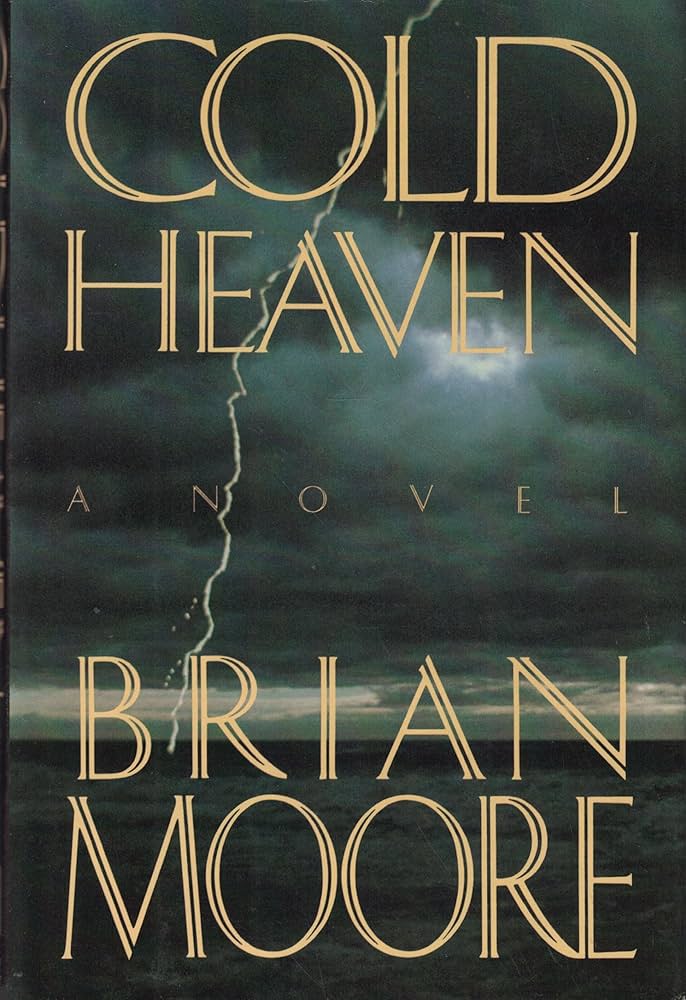
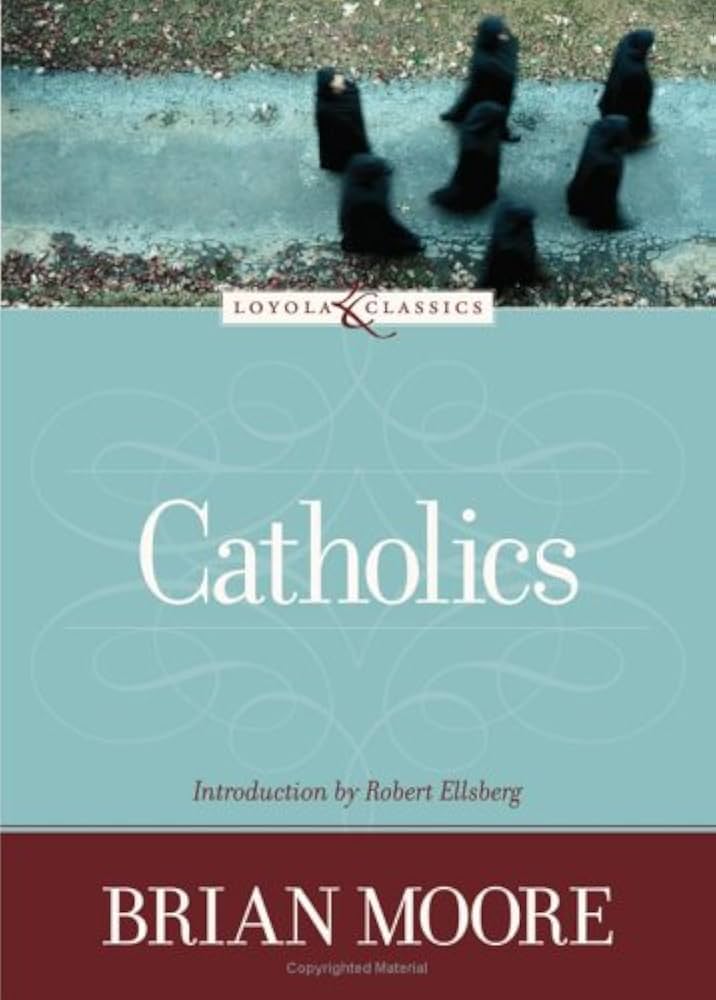
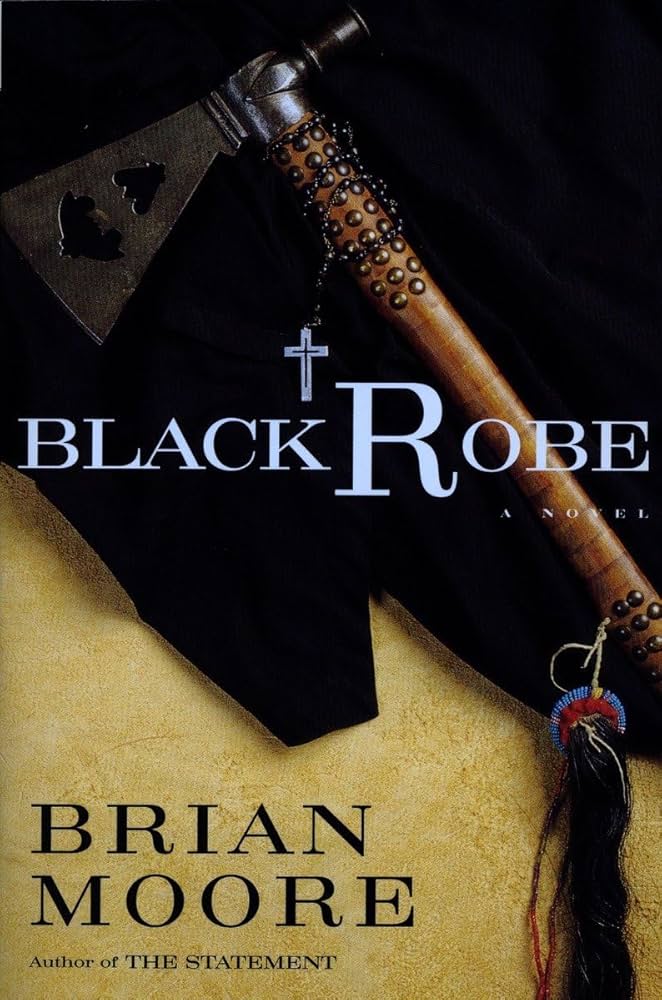
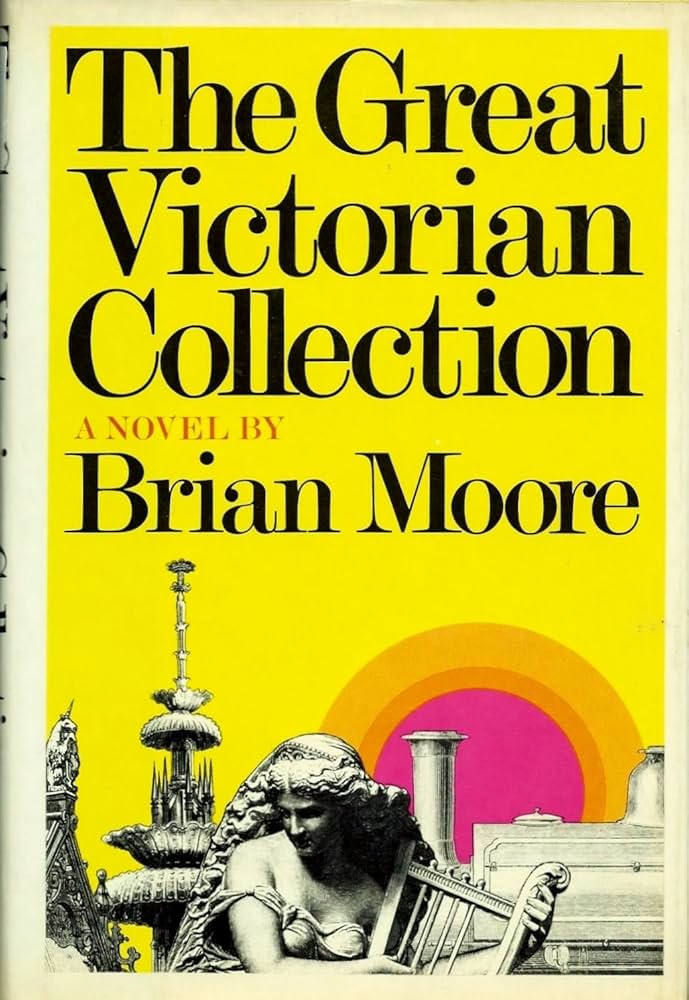

Recent comments